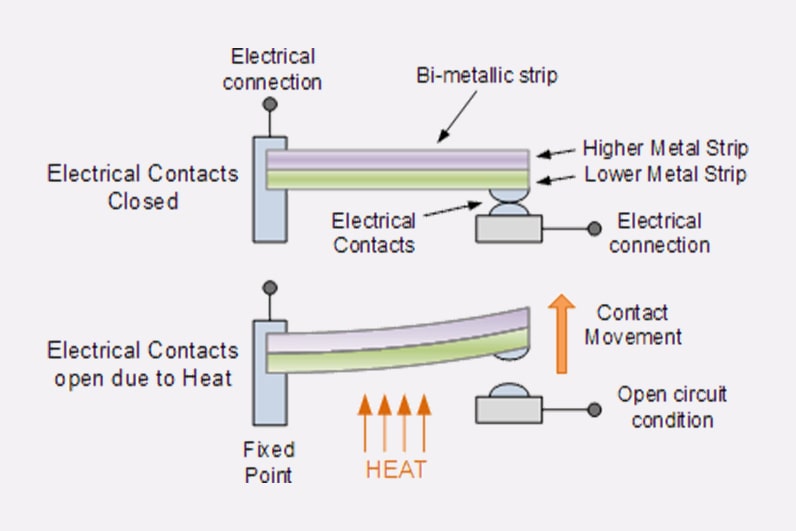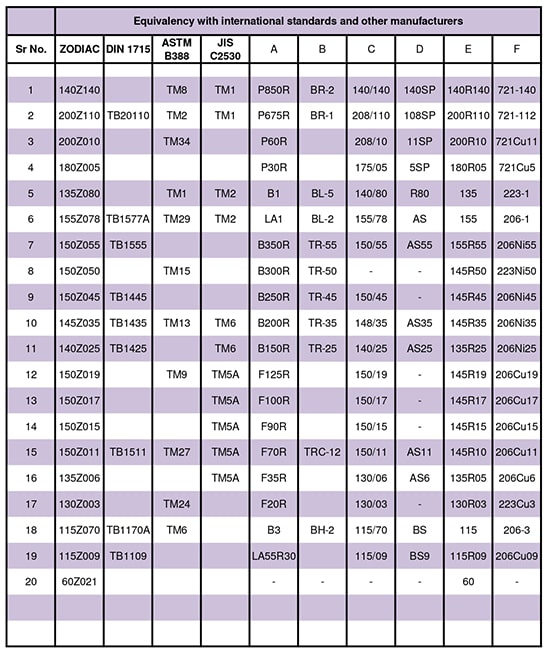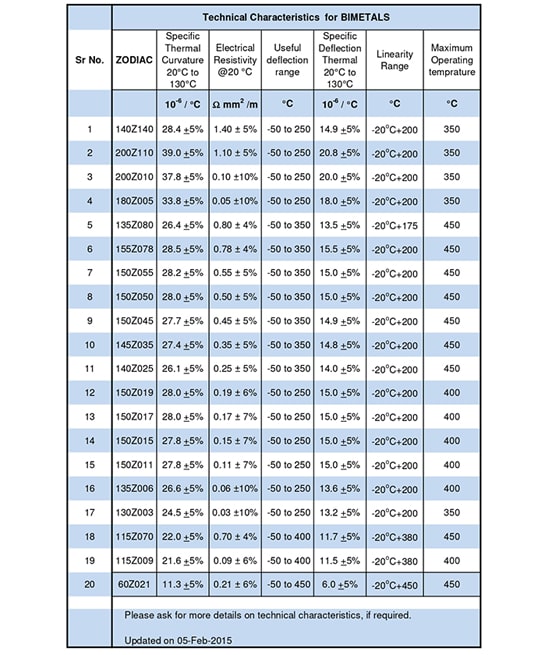Thermostatic Bimetals

Thermostatic Bimetals
Thermostatic Bimetals, are temperature sensitive materials generally consisting of two layers of alloy strips having different coefficients of thermal expansion, bonded together into a composite strip.
Bimetals Component
Processing
Shape
The effect of Bimetal components’ width on the deflection value is difficult to estimate. However as long as the width is not more than about 10% of the effective length, its influence can be neglected. With larger widths it must be borne in mind, that the bimetal will in fact, try to curve into spherical shell shape. However in the case of pure elastic stress this is possible only within very narrow limits. Because of this, with continued heating the spherical shell shape transforms readily into that of cylindrical shape, the curvature parallel to the axis of the cylinder is then complicated internal stress field arises
To avoid this, the working portions of bimetals are kept narrow by cutting or punching of slots,. The maximum width should generally not be greater than 15% of the working length. The width/thickness ratio is also important; in normal circumstances it should not exceed 20:1.

Circular thermostatic bimetal discs represent an exceptional case. These usually have sufficient thickness for good reproducibility so that the deflection per disc is small and the effects described above are unimportant. By stacking discs arranged in the same or in opposite senses or combination of the two possibilities the total force or the total deflection can in fact be adjusted within wide limits (stack of discs).
Thermostatic Bimetal is produced in the form of strips from which bimetal parts are either cut or punched out. It is of some consequence here whether the working length of the parts arranged parallel or the right angles to the direction of rolling of the strip; in the latter case a 1~2% less deflection is expected than when working length and rolling direction are parallel.
Thermostatic bimetals are provided with markings on the surface of the active component. It often happens however with punched parts that the markings has subsequently to be removed or is obscured be electrodeposited layers. In order that punched parts can be fitted the correct side up it is strongly recommended that some measure of asymmetry in their shape be provided, which is most simply done by chamfering an edge. Embossed markings are retained through successive working processes, but with very small pieces their legibility may become poor; deliberate asymmetry is better and simpler.
Forming
For sharp bends it is important to note that material fractures are more likely to occur if the bending edge is parallel rather than perpendicular to the direction of rolling. The inside bending radius should not be less than the strip thickness and it is advisable to reach agreement on the hardness of the thermostatic bimetal, as this is governed by the magnitude of the final deformation.
Winding of spirals or helices like forming of bimetal parts takes place at room temperature. Under some conditions a rise in temperature occurs during forming operations so that parts no longer possess quite the desired form after cooling. It should be noted that with subsequent artificial ageing it is possible to reverse a small part of previously effected deformation.
Fixing
The proper mounting bimetal components is important if they are to function satisfactorily. Fixing of bimetal elements is conveniently carried out by spot welding, and in appropriate circumstances by riveting, bolting, or even by soft soldering. Brazing or torch welding are out of the question for fixing as too high temperatures arise which would cause softening of the bimetal.
The cutting of threads is also possible, if bimetal with sufficient thickness is used. The hardness of the material in some cases, however, causes considerable tool wear. If the material is too thin to accommodate a sufficient number of threads, threaded bushes can be inserted.
When there is a risk of corrosion, care should be taken that bimetal does not form a voltaic cell with the support or means of fixture i.e. rivet or bolt. When spot welding, which is possible with all bimetal grades, excessive heating should be avoided; the softening areas should be confined to the actual welding point to prevent plastic deformation of the bimetal at the fixing point. Thorough degreasing of the parts is necessary before spot welding. With ZODIAC 200Z110 & 140Z140, spot welding should proceed from the passive side.
Corrosion protection
Thermostatic Bimetal consisting of the nickel-iron alloys in fact corrode more slowly in a moist atmosphere than iron, but they are not rust resistant. In contact with water corrosive attack soon begins, particularly if the water is fairly warm or if it is not neutral, but weakly acid or basic. Not only is a gradual erosion of material from the surface observed, but also the stress corrosion effect also frequently occurs, when as a result of simultaneous corrosive attack and elastic deformation the structure becomes increasingly riddled with cracks.
Where there is a risk of rusting, surface protection is always advisable. Metal coats are the first choice for surface protection, and they are best electro-deposited; nickel, tin, silver, lead, zinc, cadmium and chromium are among the most commonly used protective coats. It is essential that the coatings are soft, free from pores and impervious as only then can they provide adequate corrosion protection. If these layers are sufficiently thin compared with the thickness of the bimetal, the thermal deflection is not materially affected. As a guide we may take it that the thickness of the protective coat should not exceed 0.015mm on each side. This means for a 1 mm thick strip an increase in thickness of 3% and, correspondingly, a reduction of the deflection by about the same amount. When very high precision is required, efforts will naturally be made to keep the coating thin as possible, while at the same time maintaining its protective action.
With temperatures of application up to 100 degree C a thin plastic coating having adequate resilience is also feasible.
Because of the cut edges bimetals with previously electroplated protective coats are not completely resistant. Good corrosion protection is assured only if finished parts are covered with the coating in such a way that all cut edges are protected.
For use in water combinations of two different protective layers have performed well; for example, nickel and cadmium, nickel and tin, tin and zinc. The nature and thickness of the coating to be plated depend on the type of corrosion attacks expected.
When bimetals are only superficially protected and protective layer is damaged, an attack invariably follows which because of mechanical stresses present in the bimetal usually leads to stress corrosion and hence to destruction of the bimetal.
Technical Characteristic
Equivalency with International Standards and Other Manufacturers

Technical Characteristics for BIMETALS



Download PDF

Let's Talk
Bahadurgarh-124507, Haryana, India.
